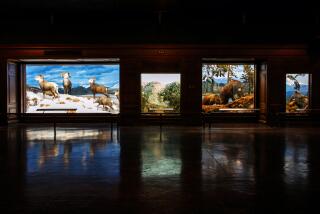The Orangutans Are Moving On Up
- Share via
Rose-Marie Weisz grew up on a cattle ranch in North Dakota; now her job is managing very different animals: orangutans.
The four orangutans at the Los Angeles Zoo--Eloise, Bruno, Rosie and Kalim--recently moved into a new $6.5-million habitat, called the Red Ape Rain Forest. The new exhibit replicates the creatures’ natural habitat in Borneo and Sumatra with 20-foot bamboo, fruit trees, and a recirculating stream that runs through the 6,000-square-foot area.
Weisz joined the Zoo in 1985 as a volunteer and has been the orangutan keeper for almost eight years.
Question: Put in human terms the difference between the space where the orangutans were and where they are now.
Answer: It would be from a low-ceilinged room to a cathedral. Think of a room that’s very familiar to you, and then imagine if, all of a sudden, you became weightless, how differently you would furnish it. You could use every inch of the volume, rather than just being on the ground.
Before, we had an open exhibit where they were very limited and the climbing structures weren’t very high. And now the entire exhibit is a climbing structure.
Q: How have they responded to the new habitat?
A: We started moving them on June 27 into the off-exhibit areas. And then there were some recovery days. First they had to recover from the drugs [given to dull them for the move], but it was also so overwhelming that they weren’t acting like themselves.
Once they were alert and active, we put them into the exhibit area. That was on Independence Day. They’re still really checking things out--and waiting for the other shoe to drop. They’re really suspicious. They’ve never had this many options and choices in their lives.
Q: How do orangutans show their intelligence?
A: Their problem-solving ability is incredible. They’re also great mimics. If they see something, they’ll try to imitate it. In the old exhibit, some workmen were digging postholes for a new fence, and the orangutans found that fascinating and watched them all day. The workers were digging close to the moat, and a rock fell into the moat.
Then, then next day, there were holes in the concrete and gunite in the exhibit. They decided they were going to dig their own postholes [with that rock].
Q: How did you go from docent to zookeeper?
A: I started doing small animal shows and outreach programs. Through that I got to know more and more keepers and got familiar with what they did. I just got addicted and decided that this is what I wanted to do.
I took the keeper class at the zoo; it’s sort of on-the-job training. Everybody thinks they want this job, and they have this idealized view of romping with the animals and having a bird perched on their finger. They don’t realize that it’s physically hard work and dangerous. It winnows down to a few of the ones who start in this huge class. And then you have to take a civil service exam.
Q: What do you do with the animals on a daily basis?
A: It’s basically a lot raking, shoveling, hosing, food preparation. . . . That’s the physical sort of stuff. And we work with the veterinarians and administrators, and we also need to observe the animals and know their personalities to recognize symptoms if they’re sick or injured. It’s mentally exhausting. Even if we accomplish what we set out to do, we have to consider how everything impacts the animals, plus how to keep yourself safe.
Q: How is the new exhibit different for visitors?
A: The exhibit itself is almost like a lumpy doughnut, looking at it from the top. Once the plants are established around the outside, the only way the visitors will see it is from the hole of the doughnut. There are two ways to get to the hole, and the orangutans [move above] both of those pathways.
Q: How is this better for the orangutans?
A: Our premise was: No one has ever built a good orangutan exhibit. What makes this exhibit good is height. They’re arboreal. They’re wholly built for life in the trees. They have to get above the ground. And they aren’t social animals, except for juveniles and mothers with babies. They need space away from each other.
BE THERE
Red Ape Rain Forest opens today at the Los Angeles Zoo, in Griffith Park at the junction of the Ventura and Golden State freeways. Zoo hours: Mondays through Thursdays, 10 a.m. to 6 p.m.; Fridays through Sundays, 10 a.m. to 7 p.m. (Hours change after Labor Day.) $8.25 adults. $3.25 ages 2 through 12. (323) 644-6400.
More to Read
Sign up for Essential California
The most important California stories and recommendations in your inbox every morning.
You may occasionally receive promotional content from the Los Angeles Times.













